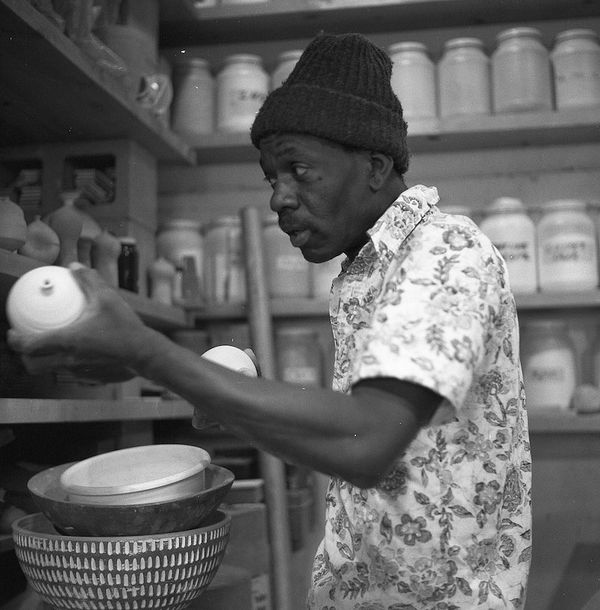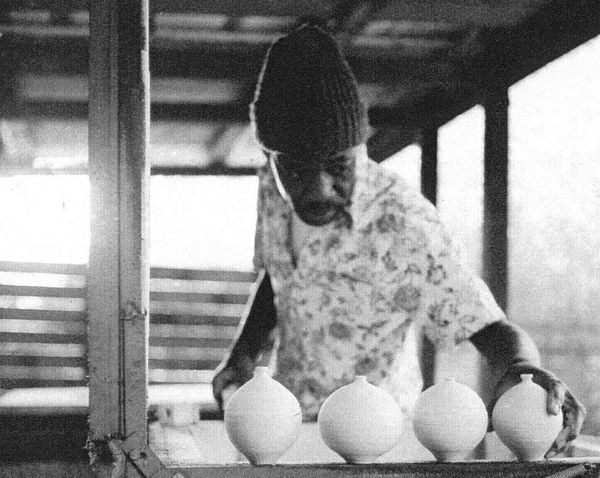Doyle Lane. Photography by Ben Serar.
“I think I wouldn’t be good as a teacher, as I don’t think there are that many who want the state of perfection that I do,” explained Doyle Lane in 1993. “But then I also say, ‘Why do it if you don’t do it to perfection?’”
An exacting, bibliophilic artist with an experimental bent, Doyle Lane was a mid-to-late twentieth century ceramist who created beads, pots, and clay paintings of luminous color, using the most temperamental glazes. Although today he is little known outside of ceramic circles, his name is finally earning the canonic status it deserves. In honor of his circa 1960 weed pot being offered at our New York Design auction, we’ve rounded up five things to know about the artist.
1. He was a significant figure of West Coast ceramics.
Despite being lesser-known than some of his contemporaries, the most important thing to know about Doyle Lane is that he was a visionary ceramist. Born in New Orleans in 1923, Lane grew up in East Los Angeles in the 1950s, studied at the University of Southern California, and received training from leading designers such as Glen Lukens, F. Carlton Ball and Vivika Heino.
From the 1950s onward, Lane became a significant figure in West Coast ceramics, creating small-scale pots and large-scale architectural works. Although, as a Black artist, he did not have the same opportunities for gallery representation as his white colleagues, Lane exhibited his work during his lifetime, and it was collected and commissioned. He showed, for example, at Ankrum Gallery and Brockman Gallery, a Black-owned gallery that also became an important exhibition space for artists like David Hammons and John Outterbridge.
Doyle Lane, Weed Pot, circa 1960. Estimate $6,000 - 8,000. Design New York.
2. He supported himself through his artwork alone.
As today, many of Lane’s midcentury colleagues supplemented their artistic income with revenue from another profession, such as teaching. Although Lane took on other work, like consulting on glazes for local ceramic suppliers, he supported himself through his artistic endeavors and expertise. Even though he secured large-scale commissions, Lane often had to think creatively about how to promote and sell his work. He sold at craft shows and walked around upscale Los Angeles neighborhoods or visited architecture offices, looking for new clients.
His commitment to focusing on his art also affected the narratives he promoted. In a 1981 interview, Lane explained, “I’ve never had the urge to make a social statement in my art. It’s nice if you can do that. Some of the artists who do those things have other incomes; they’re not making their living from just their art.”
3. His weed pots are full of personality.
Recently the subject of an exhibition at David Kordansky Gallery, Doyle Lane’s “weed pots” are among his best-known and best-loved work. The small-scale pots are named for the narrow, dried flowers that they are intended to hold and, despite their diminutive size, are revelations of color, technique, and texture. Their elegant, classical shapes are complemented with imaginative glazes. Some are plum-like, rounded, and smooth; some have the rugged surface of an autumnal gourd; some look like modernized treasures from antiquity. Many people have been taken in by their charms; David Kordansky called them “magic crystals” and Jonathan Griffin, writing for The New York Times, called them “ravishingly seductive.”
Doyle Lane. Photography by Ben Serar.
4. He went on to make “clay paintings.”
In addition to his weed pots, Lane is well-known for innovative structures that he termed “clay paintings,” in his movement away from functional objects. These mural-like works, in the words of artist Ricky Swallow, “have a more authoritative presence both in physicality and expression.” The clay paintings were assembled from glazed clay slabs applied under intense heat to create variations in texture and color (and so they could be displayed outdoors). Perhaps the most famous examples is now at the Huntington Library. At 17-feet wide and 8-feet high, the mural is as monumental as it is meticulously irregular. Lane carefully brought out the unique colors, textures, and light from each individual tile. As James Glisson, formerly the Virginia Steele Scott chief curator of American art at the Huntington, wrote, “Lane turned each small tile into an abstract painting.”
5. His work is being offered at Phillips for the first time.
Doyle Lane’s work has been featured in numerous solo and group exhibitions and is held in the permanent collections of Los Angeles County Museum of Art, the Smithsonian American Art Museum, and the California African American Museum, but since his death in 2002, Lane’s market has largely remained in California. His circa 1960 weed pot is the first work by Lane to be sold at Phillips and demonstrates the expanding reach and recognition of his remarkable, visionary oeuvre.
Discover More from Design New York >
Recommended Reading
The Legendary Origins of a 'Grecque' Table Lamp >




